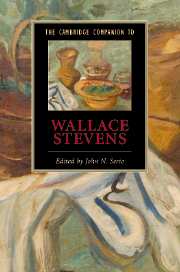Book contents
- Frontmatter
- Introduction
- 1 Wallace Stevens: A Likeness
- 2 Stevens and Harmonium
- 3 Stevens in the 1930s
- 4 Stevens and the supreme fiction
- 5 Stevens’ late poetry
- 6 Stevens and his contemporaries
- 7 Stevens and romanticism
- 8 Stevens and philosophy
- 9 Stevens’ seasonal cycles
- 10 Stevens and the lyric speaker
- 11 Stevens and linguistic structure
- 12 Stevens and painting
- 13 Stevens and the feminine
- 14 Stevens and belief
- Further reading
- Index
Introduction
Published online by Cambridge University Press: 28 May 2007
- Frontmatter
- Introduction
- 1 Wallace Stevens: A Likeness
- 2 Stevens and Harmonium
- 3 Stevens in the 1930s
- 4 Stevens and the supreme fiction
- 5 Stevens’ late poetry
- 6 Stevens and his contemporaries
- 7 Stevens and romanticism
- 8 Stevens and philosophy
- 9 Stevens’ seasonal cycles
- 10 Stevens and the lyric speaker
- 11 Stevens and linguistic structure
- 12 Stevens and painting
- 13 Stevens and the feminine
- 14 Stevens and belief
- Further reading
- Index
Summary
The poetry of Wallace Stevens presents a paradox. On one hand, those who know and love his poetry consider him one of America's finest poets. Some critics have singled out particular poems such as “Sunday Morning” and “The Snow Man ” as among the best ever written. Enthusiasts enjoy his comic spirit and delight in the freshness of his unusual subjects - placing a jar in Tennessee, eating ice cream at a funeral, dancing around a dead stump. They marvel at the way his musical lines dazzle one into affirming what is undeniably illogical - “Music is feeling, then, not sound,” and “Beauty is momentary in the mind . . . / But in the flesh it is immortal” (72-75). They are moved by his expressions of loss, alienation, and despair. But more than this, they see Stevens as a major poet because he addresses major themes: the relationship between the world and the mind, the beauty of planet Earth as an end in itself, poetry (or art in general) as an affirmation of life, the problem of belief in a secular age, the need for creating a sense of nobility in a crass and violent world. They regard Stevens as a great poet because he infuses these subjects with authentic feeling, so that each becomes “An abstraction blooded, as a man by thought” (333).
On the other hand, most people have never heard of Wallace Stevens. Among those who have, many find his work intimidating and “too difficult” to comprehend. Stevens himself is in part responsible for his lack of a wide readership. Reticent by nature, he was not a self-promoter as were some of his contemporaries such as Ezra Pound, T. S. Eliot, and Robert Frost. Although late in life Stevens did accept a number of accolades, he was uncomfortable at the ceremonies and escaped them as quickly and with as little notice as possible. He cringed at opportunities for publicity, declining both Life and The New Yorker when they wished to run profiles on him. When he received the Bollingen Prize in Poetry, he curtly declined to be interviewed by a local newspaper reporter. The front-page article in the Hartford Courant, carrying a three-year-old photograph of him, noted that he had nothing to say except “hurry.”
- Type
- Chapter
- Information
- The Cambridge Companion to Wallace Stevens , pp. 1 - 7Publisher: Cambridge University PressPrint publication year: 2007
- 1
- Cited by

